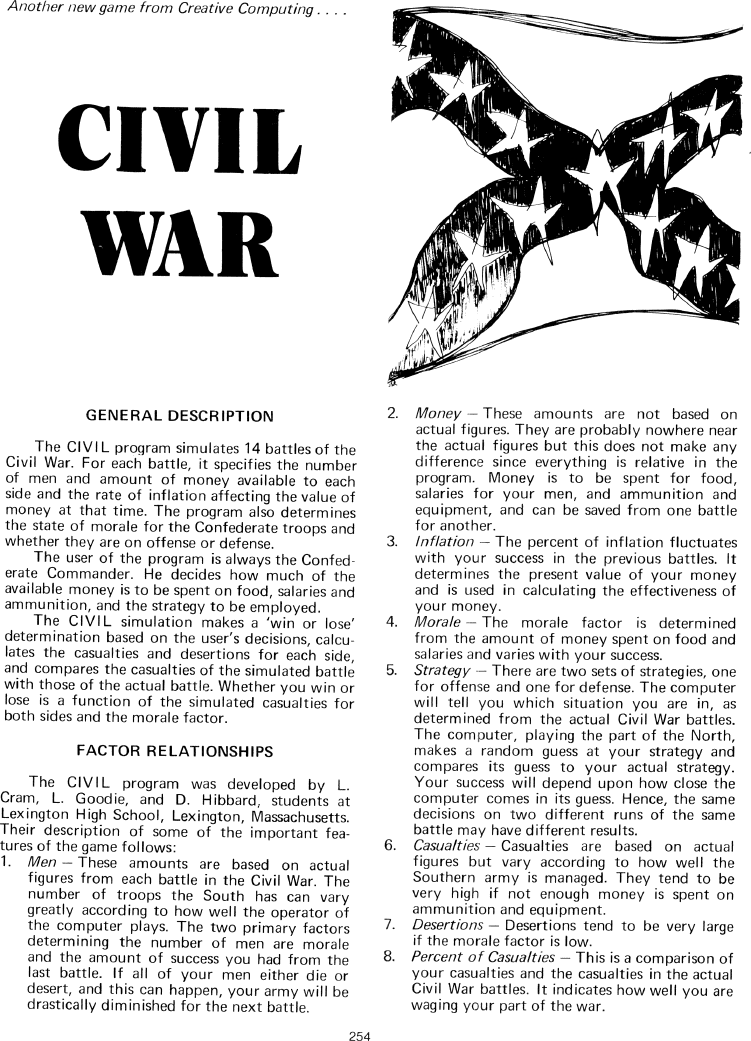The Best of Creative Computing Volume 1 (published 1976)
Civil War (BASIC computer game, war simulation)

Another new game from Creative Computing….
CIVIL
WAR
GENERAL DESCRIPTION
The CIVIL program simulates 14 battles of the Civil War. For each battle, it
specifies the number of men and amount of money available to each side and the
rate of inflation affecting the value of money at that time. The program also
determines the state of morale for the Confederate troops and whether they are
on offense or defense.
The user of the program is always the Confederate Commander. He decides how much
of the available money is to be spent on food, salaries and ammunition, and the
strategy to be employed.
The CIVIL simulation makes a 'win or lose' determination based on the user's
decisions, calculates the casualties and desertions for each side, and compares
the casualties of the simulated battle with those of the actual battle. Whether
you win or lose is a function of the simulated casualties for both sides and the
morale factor.
FACTOR R E LATIONSHIPS
The CIVIL program was developed by L. Cram, L. Goodie, and D. Hibbard, students
at Lexington High School, Lexington, Massachusetts. Their description of some of
the important features of the game follows:
1. Men - These amounts are based on actual figures from each battle in the Civil
War. The number of troops the South has can vary greatly according to how well
the operator of the computer plays. The two primary factors determining the
number of men are morale and the amount of success you had from the last battle.
If all of your men either die or desert, and this can happen, your army will be
drastically diminished for the next battle.
<image>
2. Money - These amounts are not based on actual figures. They are probably
nowhere near the actual figures but this does not make any difference since
everything is relative in the program. Money is to be spent for food, salaries
for your men, and ammunition and equipment, and can be saved from one battle for
another.
3. Inflation - The percent of inflation fluctuates with your success in the
previous battles. It determines the present value of your money and is used in
calculating the effectiveness of your money.
4. Morale - The morale factor is determined from the amount of money spent on
food and salaries and varies with your success.
5. Strategy - There are two sets of strategies, one for offense and one for
defense. The computer will tell you which situation you are in, as determined
from the actual Civil War battles. The computer, playing the part of the North,
makes a random guess at your strategy and compares its guess to your actual
strategy. Your success will depend upon how close the computer comes in its
guess. Hence, the same decisions on two different runs of the same battle may
have different results.
6. Casualties - Casualties are based on actual figures but vary according to how
well the Southern army is managed. They tend to be very high if not enough money
is spent on ammunition and equipment.
7. Desertions - Desertions tend to be very large if the morale factor is low.
8. Percent of Casualties - This is a comparison of your casualties and the
casualties in the actual Civil War battles. It indicates how well you are waging
your part of the war.
254


